10 Backyard Fermentation Station Ideas to Transform Your Outdoor Space
1. Repurposed Garden Shed
Transform an unused garden shed into a dedicated fermentation workshop. Install shelving units along the walls to store your fermenting vessels and equipment. Add a small workbench for preparing ingredients and checking on your ferments. The enclosed space provides protection from the elements while giving you plenty of room to experiment with multiple projects simultaneously.
2. Pergola Fermentation Zone
Create a stylish fermentation area under a pergola. The partial shade protects your ferments from direct sunlight while allowing airflow. Hang climbing plants like grapes or hops on the structure for both decoration and possible fermentation ingredients. Place a weatherproof table and storage cabinet underneath for a functional workspace that blends beautifully with your garden industry.
3. Converted Bar Cart Station
Repurpose a bar cart or rolling kitchen island for an adaptable fermentation station. These mobile units let you move your ferments to optimal locations based on weather conditions. Store your equipment in the lower shelves and display active fermentation projects on the top. Choose a cart with a weather-resistant surface and wheels that lock for stability when stationary.
4. Wall-Mounted Barrel System
Install wall-mounted barrels along a fence or exterior wall for efficient space usage. This setup works especially well for fermenting beverages like kombucha, beer, or wine. The elevation helps with temperature regulation and makes sampling easy through built-in spigots. Add a small shelf nearby for storing testing equipment and ingredients.
5. Upcycled Window Greenhouse
Convert an old window frame into a mini greenhouse fermentation station. This creates a controlled environment for temperature-sensitive ferments while allowing you to monitor them visually. Build shelving inside for different fermentation vessels and include a thermometer to track internal conditions. The transparent walls create an attractive display of your fermenting foods.
6. Multi-Tiered Pallet Shelving
Construct rugged shelving units from reclaimed wooden pallets for an eco-friendly approach. Create multiple tiers to organize different fermentation projects by type or stage. Treat the wood with food-safe sealant to protect against moisture and extend its lifespan. The rustic aesthetic complements garden surroundings while providing practical storage space.
7. Solar-Powered Fermentation Cabinet
Build a dedicated outdoor cabinet with integrated solar panels to power small heating elements or cooling fans. This system helps maintain optimal temperatures for your ferments regardless of weather conditions. Include LED lighting for evening check-ins and a digital thermometer to monitor conditions. The self-sustaining energy source aligns perfectly with the sustainable nature of fermentation.
8. Underground Cellar Access
Use the natural temperature regulation of the earth by creating an underground or partially buried fermentation cellar. This traditional approach provides ideal conditions for many fermentation projects, especially those requiring long aging periods. Install a hinged door with lock for secure access and proper ventilation to prevent excess moisture buildup.
9. Potting Bench Conversion
Repurpose a potting bench into a comprehensive fermentation workstation. The built-in storage and workspace are perfect for managing multiple fermentation projects. Add hooks on the sides to hang tools and utensils, and install a small sink if plumbing allows for easy cleanup. The standing height makes checking on your ferments comfortable without bending over repeatedly.
10. Covered Outdoor Kitchen Extension
Extend your outdoor kitchen to include a dedicated fermentation corner. Install weather-resistant countertops and cabinetry specifically for your fermentation supplies and active projects. The proximity to your cooking area makes it convenient to incorporate your fermented foods into meals. Add task lighting for early morning or evening fermentation sessions when natural light is limited.
Creating a Dedicated Brewing Shed: Your Fermentation Headquarters
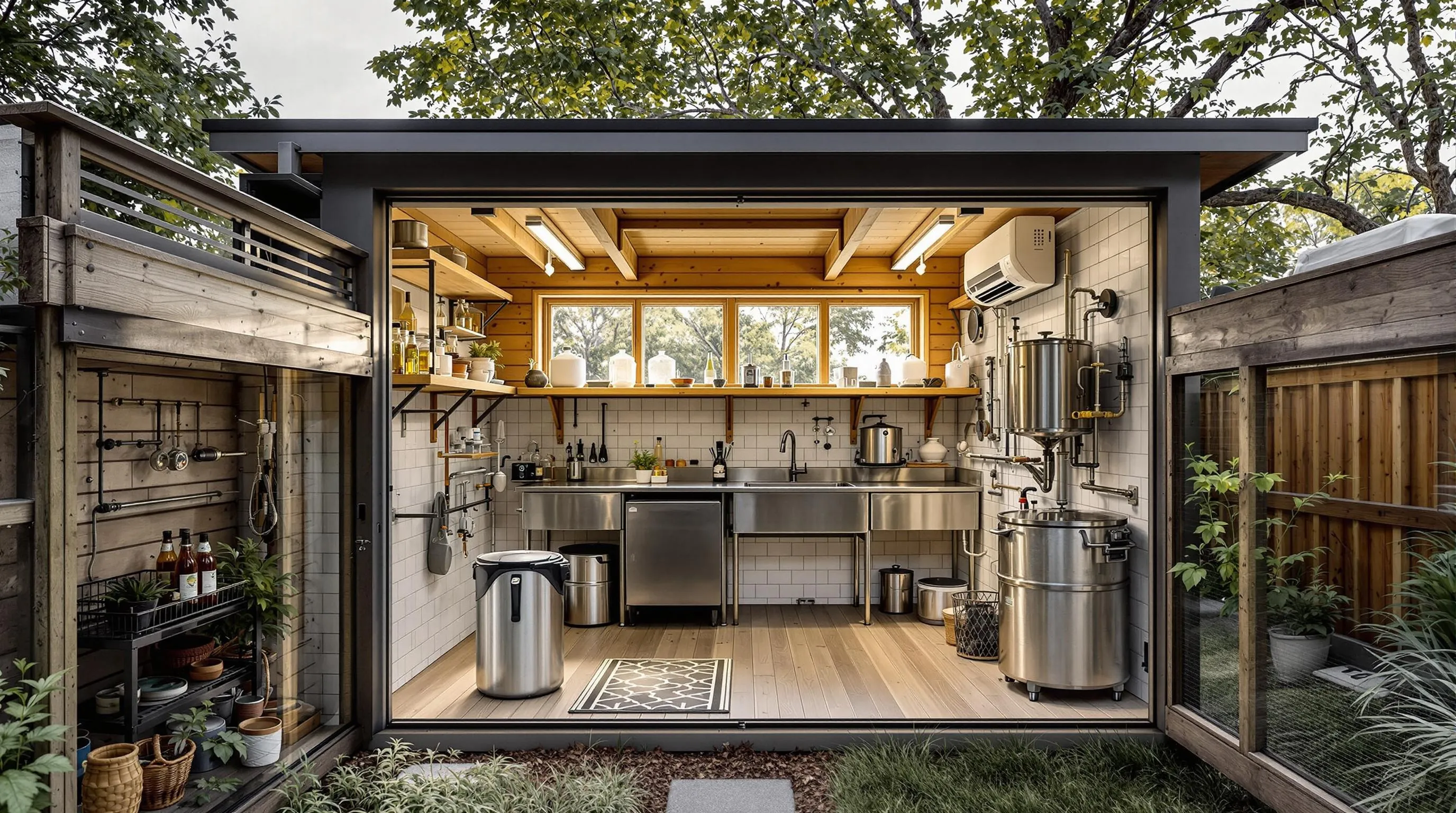
Taking your fermentation hobby to the next level means creating a dedicated space that serves all your brewing needs. A brewing shed transforms your backyard into a fermentation paradise where you can experiment, store, and perfect your create with maximum efficiency.
Essential Layout Features for a Fermentation Shed
Your fermentation shed needs thoughtful organization to function efficiently. Start with dedicated zones for different fermentation stages—preparation, active fermentation, and storage. Install sturdy countertops at comfortable working heights (36-38 inches) with heat-resistant surfaces like stainless steel or butcher block. Incorporate plenty of storage with adjustable shelving systems that accommodate vessels of various sizes. A utility sink with hot and cold water is crucial for cleaning equipment and ingredients. Position your electrical outlets strategically above countertops and include GFI protection for safety. Add proper lighting with a combination of overhead LEDs (5000K) for task work and softer ambient lighting. Finally, include a small reference area with a bulletin board for tracking fermentation schedules and storing your favorite recipes.
Climate Control Considerations for Year-Round Fermenting
Maintaining consistent temperatures is critical for successful fermentation projects throughout the year. Insulate your shed walls, ceiling, and floor with high R-value materials (minimum R-13 for walls, R-19 for ceiling) to create a stable environment. Install a mini-split heating and cooling system that allows precise temperature control between 55-75°F depending on your fermentation needs. Consider separate climate zones using insulated partitions—warmer areas for kombucha and tempeh (75-85°F) and cooler sections for cheese aging (45-55°F). Monitor humidity levels with hygrometers and use dehumidifiers in damp seasons to prevent mold growth. For energy efficiency, position your shed to minimize direct sun exposure, use double-pane windows with UV protection, and install ceiling fans to maintain air circulation. During extreme weather, thermal curtains and window coverings provide additional insulation. Consider adding a small weather station to track conditions and maintain detailed records of how environmental factors affect your fermentation outcomes.
Repurposing an Old Potting Bench into a Kimchi and Sauerkraut Station
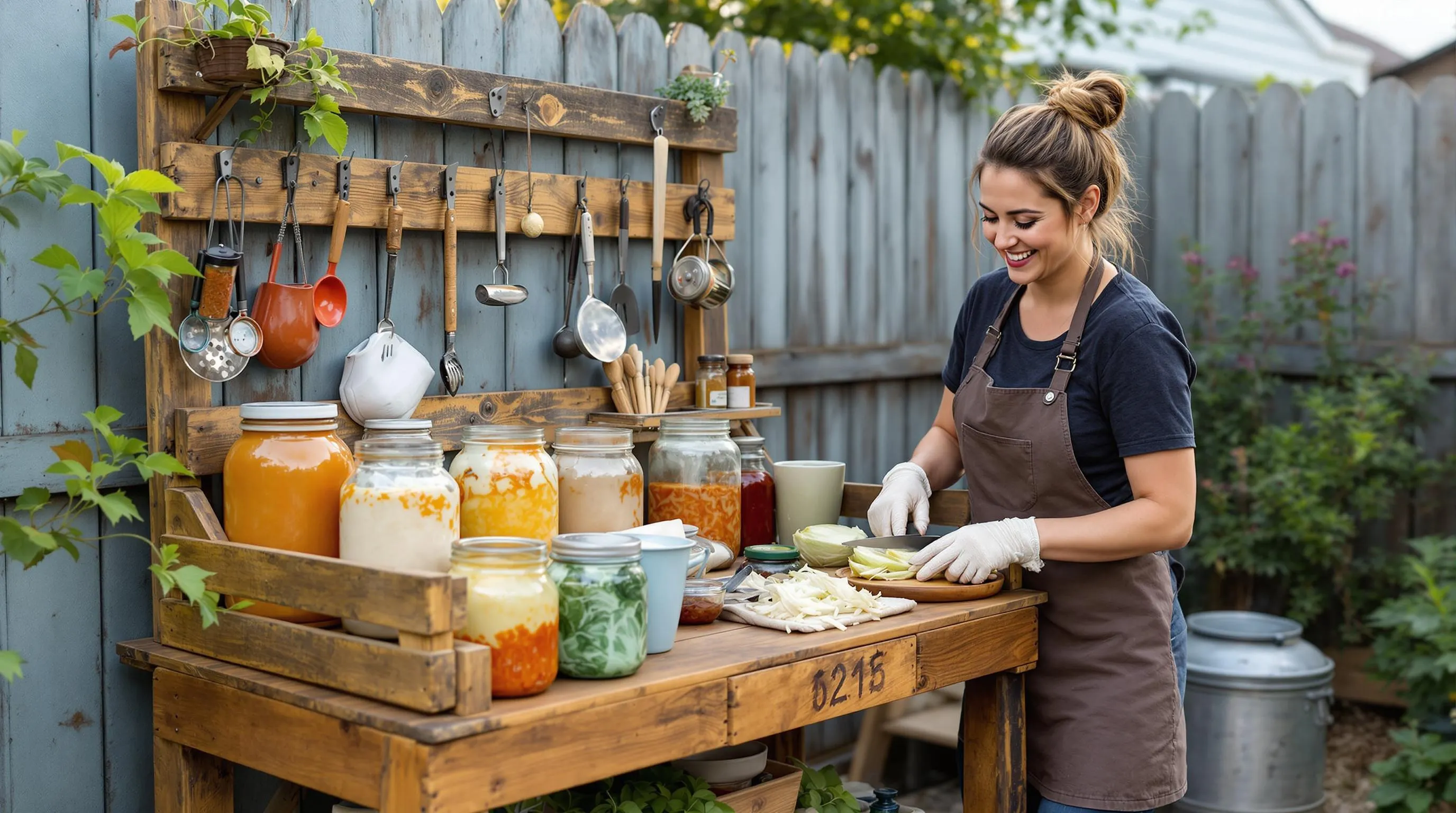
That weathered potting bench gathering dust in your garage can be transformed into a specialized fermentation station perfect for crafting homemade kimchi and sauerkraut. The existing design of most potting benches—with their sturdy work surfaces, storage shelves, and rustic charm—creates an ideal foundation for fermenting vegetables with minimal modifications required.
Space-Efficient Designs for Small Backyards
Don’t let limited space stop you from fermenting! Position your repurposed potting bench against a fence or wall to maximize your compact backyard area. Install fold-down side tables that can be raised when you’re shredding cabbage and lowered when not in use. Add stackable fermentation crocks on the lower shelves and use hanging storage systems for your tools, like mandolins, cutting boards, and cabbage crushers. Wall-mounted spice racks above the bench can hold salt varieties, pepper flakes, and other seasonings, keeping everything within reach without cluttering your work surface. Magnetic strips attached to the backsplash provide quick access to knives and metal utensils, further optimizing your small-footprint fermentation station.
Weather-Resistant Materials for Durability
For your kimchi and sauerkraut station to withstand the elements, choose weather-resistant materials for all modifications. Replace any deteriorating wood with cedar, cypress, or marine-grade plywood treated with food-safe sealants. Cover your work surface with stainless steel or food-grade HDPE cutting boards that resist moisture and won’t harbor bacteria. Install rubberized shelf liners to prevent fermentation vessels from sliding during windy conditions. Add a pitched roof overhang or a waterproof canvas cover to shield your ferments from direct rainfall and harsh sunlight. Stainless steel hinges, handles, and hardware will prevent rust contamination, while silicone gaskets around any cabinet doors create watertight seals to protect your fermenting supplies. These durable materials ensure your station remains functional through changing seasons and weather conditions.
Building a Solar-Powered Fermentation Cabinet for Eco-Friendly Brewing
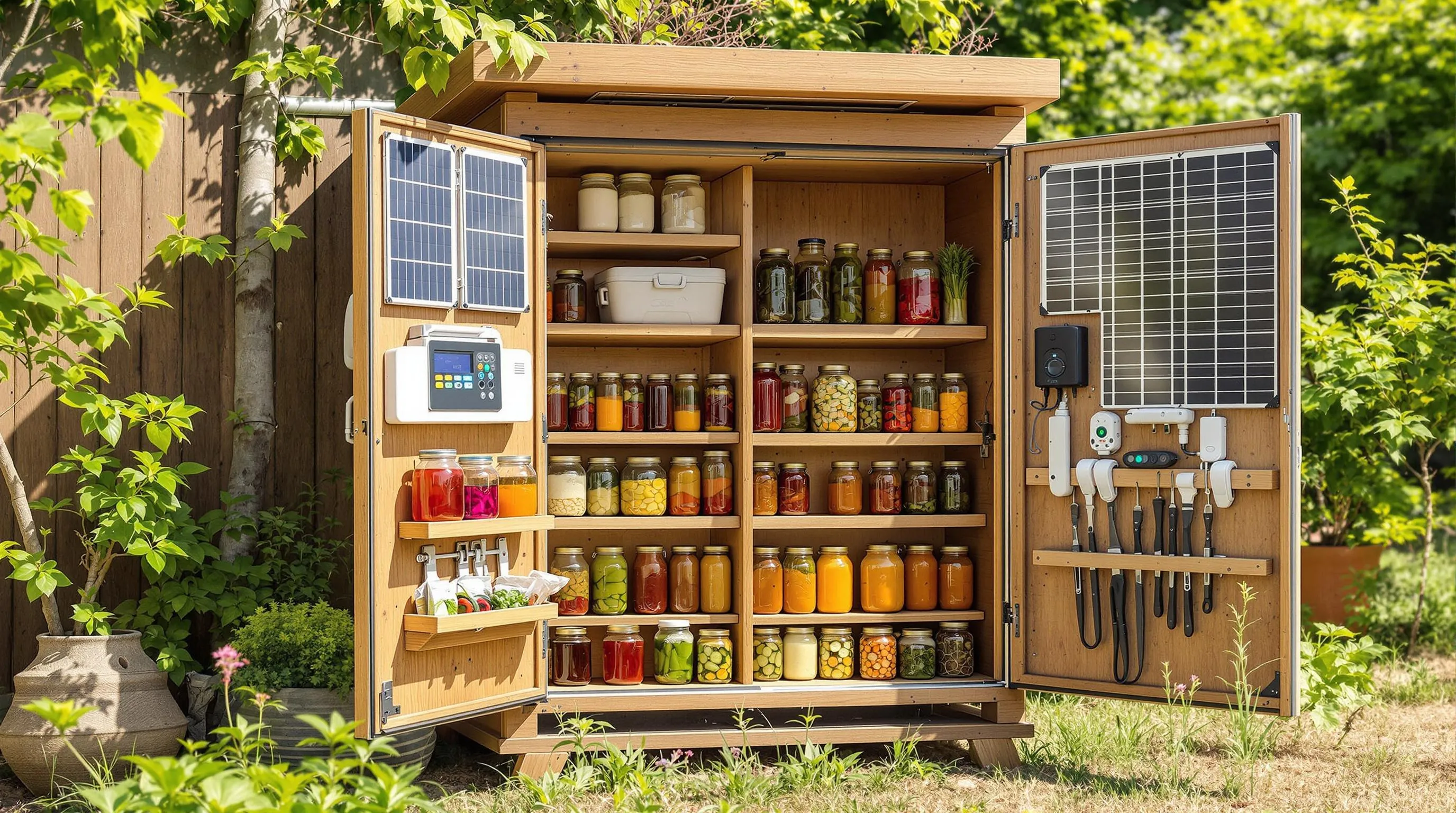
A solar-powered fermentation cabinet combines sustainability with precision brewing. This eco-friendly solution uses renewable energy to maintain optimal fermentation conditions while reducing your carbon footprint and energy costs.
Harnessing Solar Energy for Temperature Regulation
Transform your fermentation process with a solar-powered heating and cooling system that maintains ideal temperatures regardless of outdoor conditions. Start with a well-insulated cabinet made from sustainable materials like bamboo or reclaimed wood. Mount 100-watt solar panels on your south-facing roof or cabinet top, connecting them to a charge controller and deep-cycle battery for consistent power supply. Install thermoelectric coolers (Peltier devices) that can both heat and cool with minimal energy consumption. These devices, combined with a programmable thermostat, create microclimate zones perfect for different ferments—65°F for kombucha, 70-75°F for sourdough, and 55-60°F for vegetable ferments. Include air circulation fans to eliminate hot spots and ensure even temperature distribution throughout your cabinet.
Monitoring Systems for Remote Tracking
Equip your solar-powered fermentation cabinet with smart monitoring technology to track your ferments from anywhere. Install wireless temperature and humidity sensors in different cabinet zones, connecting them to a central hub powered by your solar system. Use fermentation-exact apps like Brew Tracker or FermMonitor to receive real-time alerts when conditions fall outside optimal ranges. Add automatic data logging features to document temperature patterns, helping you refine your recipes based on seasonal variations. For advanced setups, integrate pH probes and exact gravity sensors that transmit fermentation progress data directly to your smartphone. These monitoring systems not only improve fermentation outcomes but also reduce waste by preventing failed batches due to temperature fluctuations.
Installing a Backyard Root Cellar for Natural Cool Fermentation
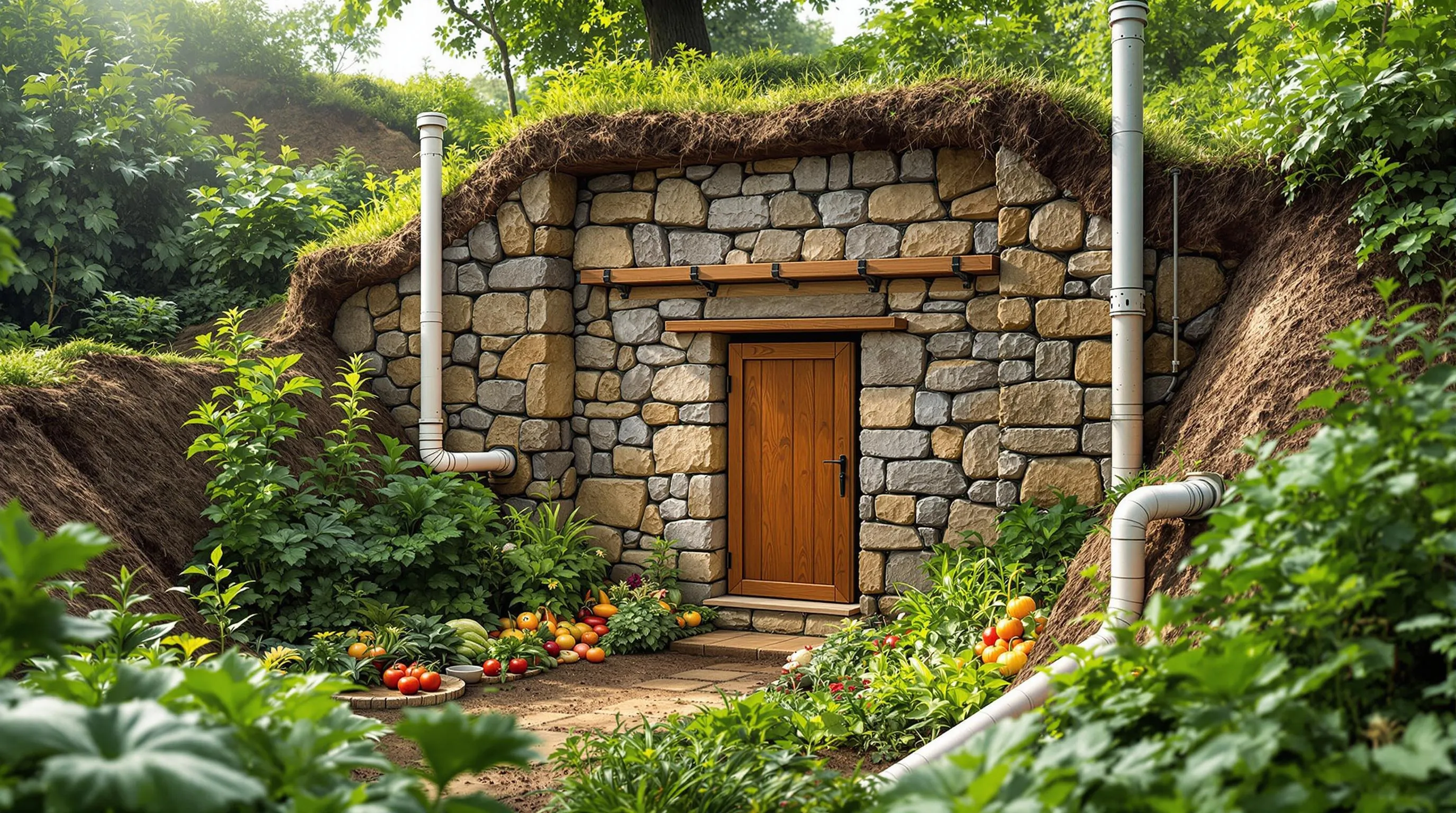
A backyard root cellar offers the perfect environment for slow, cool fermentation without electricity. This traditional storage method maintains consistent temperatures year-round, creating ideal conditions for fermenting vegetables, aging cheese, and storing preserved foods.
Underground Storage Answers for Temperature Stability
Harnessing the earth’s natural insulation properties gives your fermentation projects a stable environment regardless of seasonal changes. Dig your cellar at least 4 feet below the frost line where temperatures typically hover between 32-40°F (0-4°C) year-round. Choose between three practical designs: hillside cellars built into existing slopes, pit cellars with trap doors for small spaces, or freestanding cellars partially buried with insulated roofs. Line your walls with moisture-resistant materials like stone, concrete, or treated lumber, and install adjustable shelving at various heights for different-sized fermentation vessels. Consider adding a gravel floor with a French drain to manage moisture and prevent standing water that could spoil your ferments.
Ventilation Systems to Prevent Mold Growth
Proper air circulation is crucial for preventing mold and maintaining the right humidity levels for fermentation. Install a dual-vent system with intake and exhaust pipes positioned at opposite ends of your cellar to create natural airflow. The intake pipe should extend from the cellar floor to above ground level, while the exhaust pipe should run from the ceiling to a higher point outside. Add adjustable dampers to control airflow during extreme temperature fluctuations. For larger cellars, consider incorporating a small solar-powered fan that activates when humidity levels exceed 80%. Place hygrometers at different heights to monitor conditions, and use natural dehumidifiers like calcium chloride buckets or silica gel packs in particularly damp seasons. This balanced ventilation system creates the perfect environment for long, slow fermentation while preserving the distinctive flavors that come from natural cool aging.
Designing a Multi-Tier Kombucha Brewing Station on Your Deck
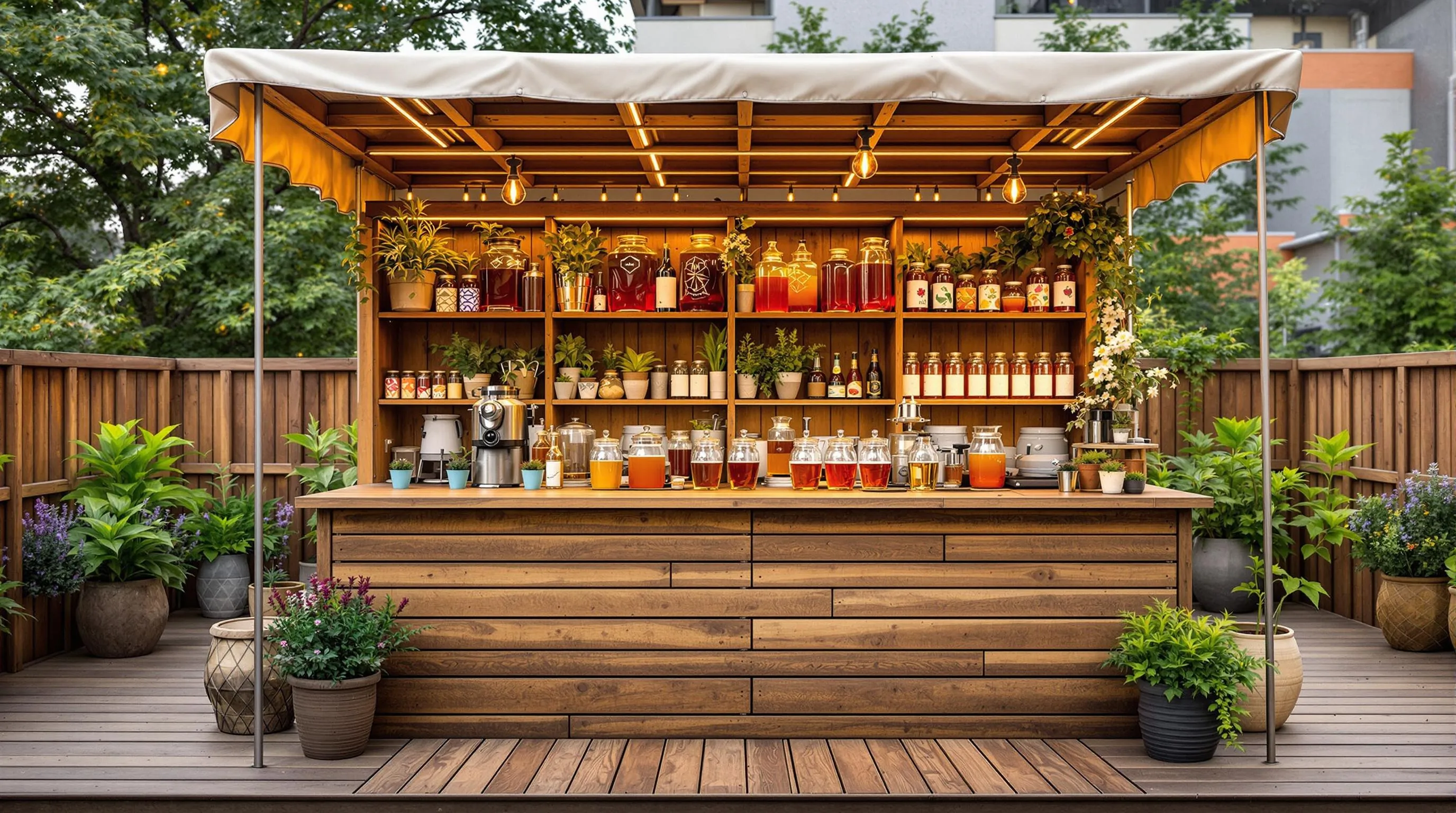
Transform your deck into a kombucha brewing haven with a multi-tier station that maximizes vertical space while creating a functional fermentation area. This setup allows you to brew multiple batches simultaneously while maintaining an organized, accessible brewing process.
Space-Maximizing Vertical Designs
Create a three-tiered brewing station using reclaimed wooden shelving or modular metal racks that can support the weight of multiple brewing vessels. Position your primary fermentation containers on the top tier where they’ll receive consistent ambient light without direct sun exposure. The middle tier serves perfectly for storing bottled kombucha during second fermentation, while the bottom level accommodates supplies, extra jars, and ingredients. Install sliding tracks on shelves for easy access to rear containers, and consider adding fold-out workspace extensions that can be tucked away when not in use. For maximum space efficiency, mount a pegboard backdrop to hang tools, thermometers, pH strips, and cleaning supplies.
Decorative Elements That Complement Outdoor Aesthetics
Integrate your kombucha station seamlessly into your deck’s existing design by selecting materials and finishes that match or complement your outdoor furniture. Install copper or bamboo accents that weather beautifully and develop character over time. Use decorative glass dispensers with spigots for serving finished kombucha during gatherings, doubling as conversation pieces. Add potted herbs like mint, ginger, and lemongrass around the station that serve both as ingredients for flavoring kombucha and as natural decor. Install subtle LED strip lighting underneath each tier to illuminate your brews at night while creating an inviting ambiance. Weather-resistant fabric canopies in colors that match your outdoor palette can provide shade protection while adding visual interest to your fermentation station.
Setting Up a Preservation Pavilion with Seasonal Fermenting Zones
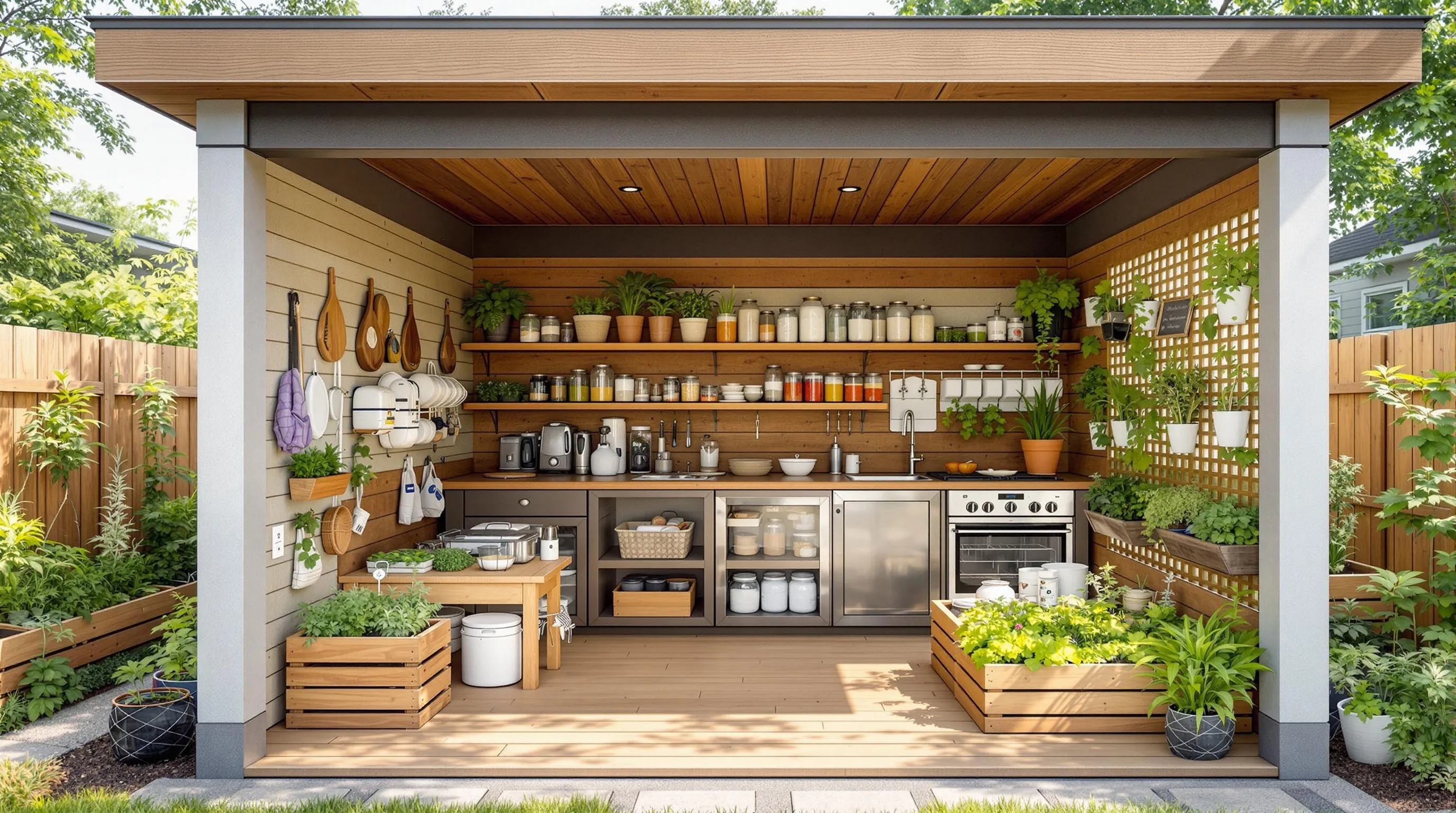
Transform your backyard into a year-round fermentation hub by creating a dedicated preservation pavilion with distinct seasonal zones. This specialized setup allows you to work with different ferments throughout the year while maintaining optimal conditions for each type.
Creating Designated Areas for Different Fermentation Types
Organize your preservation pavilion by allocating exact zones for various fermentation styles based on their unique requirements. Design a cool, shaded area for vegetable ferments like sauerkraut and pickles that benefit from consistent temperatures between 65-72°F. Include a warmer section with good air circulation for kombucha and vinegar production, which thrive at 75-85°F. Set up a dedicated dairy corner for yogurt, kefir, and cheese with easy-to-clean surfaces and temperature control options. For alcohol fermentation, create a separate zone away from direct sunlight, equipped with airlocks and specialized equipment for wine, beer, and mead. Install adjustable shelving systems with labeled sections to keep your different fermentation projects organized and prevent cross-contamination between cultures.
Incorporating Herb Gardens for Fresh Ingredients
Maximize efficiency by integrating herb gardens directly into your preservation pavilion design. Plant culinary herbs like dill, garlic, and basil in raised beds or vertical gardens adjacent to your fermentation workspace for easy access to fresh flavoring ingredients. Choose herbs that complement your fermentation projects – cilantro and mint for kimchi, tarragon for pickled vegetables, or lemon balm for kombucha. Incorporate medicinal herbs such as oregano, thyme, and rosemary that add both flavor and natural preservative qualities to your ferments. Use hanging planters or wall-mounted herb gardens to save floor space while keeping ingredients within arm’s reach. Create herb-drying stations above fermentation counters to preserve seasonal bounty for year-round use in your fermentation recipes, ensuring you’ll never run short of flavorful additions for your preservation projects.
Transforming a Garden Cart into a Mobile Fermentation Laboratory
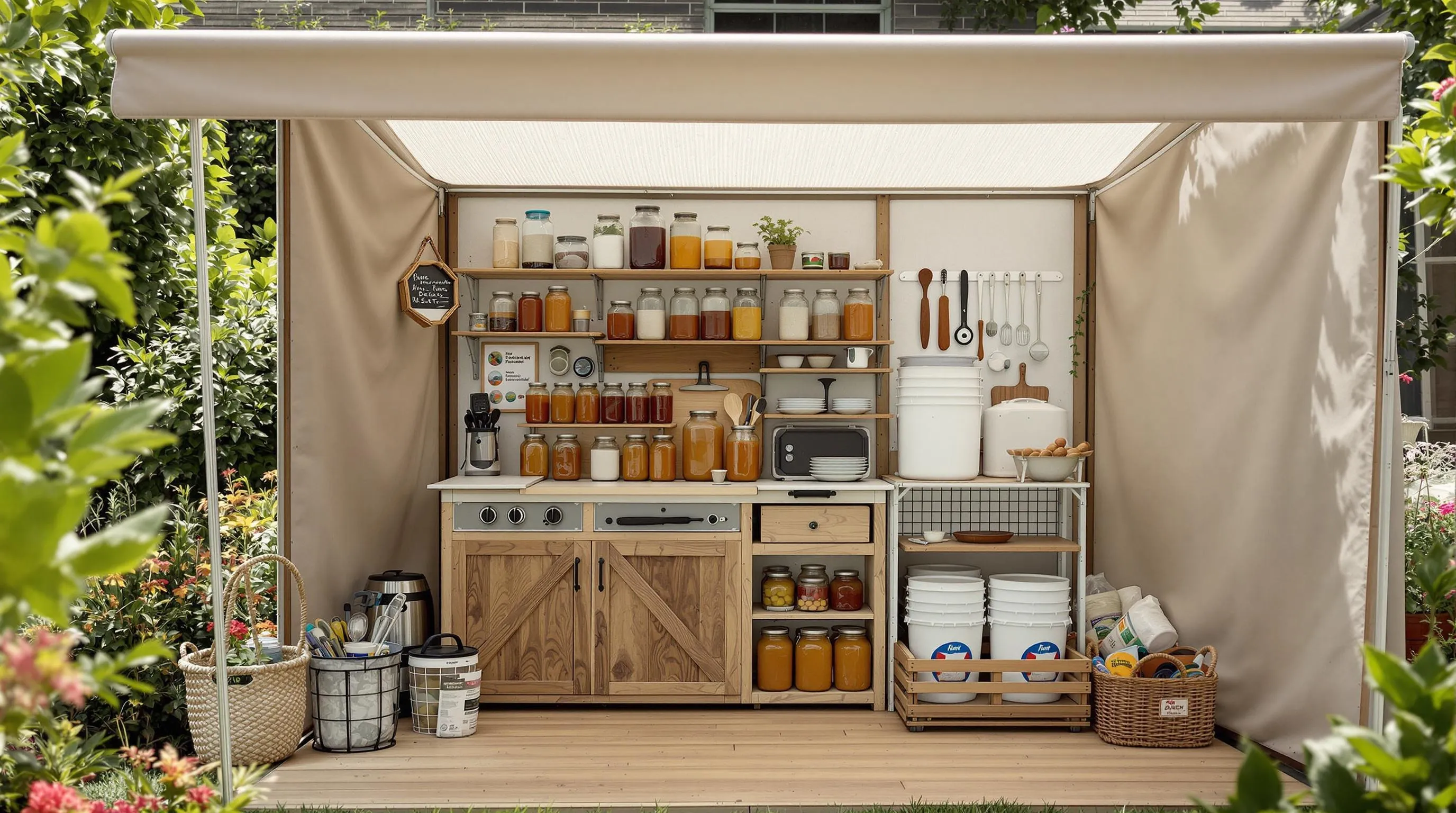
A garden cart offers the perfect foundation for creating a versatile, mobile fermentation station that can follow the sun or shade as needed. With some thoughtful modifications, your ordinary garden cart can become a functional laboratory that travels wherever your fermentation projects take you.
Tools and Equipment for a Portable Setup
Equip your mobile fermentation laboratory with essential tools that maximize functionality while maintaining portability. Start with stackable fermentation vessels in various sizes—glass jars with airlocks for small batches and food-grade plastic buckets for larger projects. Install a fold-down cutting board that serves as your preparation surface without taking up permanent space. Add a tool organizer with dedicated spots for thermometers, pH meters, wooden spoons, and measuring cups. Consider incorporating a small hand-cranked grinder for cabbage and vegetables, eliminating the need for electricity. Mount a battery-powered scale for precise measurements and a magnetic strip to hold metal utensils. Complete your setup with a waterproof container for storing fermentation-exact ingredients like salt, starter cultures, and spices, ensuring everything you need is always at your fingertips.
Weather Protection Features for Outdoor Use
Your mobile fermentation laboratory needs robust weather protection to function effectively in varying outdoor conditions. Install a retractable awning or UV-resistant canopy that extends from the cart to shield your ferments from direct sunlight and rain. Add removable side panels made from clear marine vinyl for wind protection while maintaining visibility. Incorporate a weather-resistant storage compartment with silica gel packets to keep tools dry during humid days. For temperature management, install insulated panels on the cart’s sides that can be attached or removed as needed. Consider adding a small solar-powered fan to circulate air on hot days and prevent overheating. Weatherproof all wooden elements with marine-grade sealant and replace standard wheels with all-terrain options for easy movement across wet or uneven ground. These adaptations ensure your mobile station remains functional regardless of weather conditions, allowing year-round fermentation activities.
Establishing a Fermentation Greenhouse for Temperature-Sensitive Projects
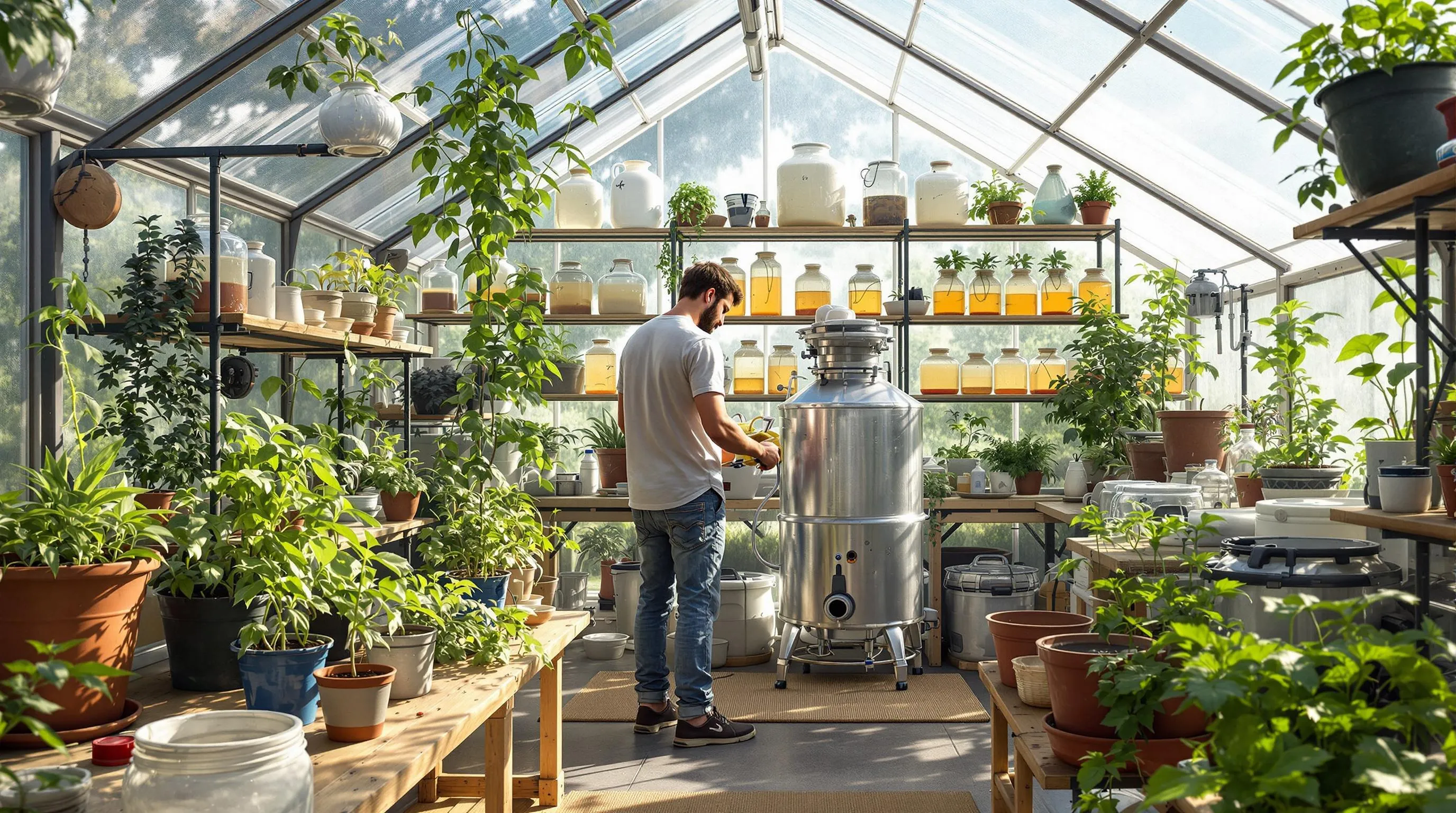
A dedicated fermentation greenhouse provides the perfect controlled environment for your more delicate fermentation projects that require exact temperature ranges. By creating this specialized space, you’ll unlock the ability to ferment year-round regardless of outdoor conditions, expanding your fermentation repertoire significantly.
Hybrid Growing and Fermenting Spaces
Transform your greenhouse into a dual-purpose sanctuary by combining plant cultivation with fermentation production. Use vertical shelving systems to separate growing areas on the bottom tiers from fermentation vessels on the upper shelves. This arrangement creates beneficial microclimates—the plants naturally increase humidity while helping regulate temperatures through transpiration. Position temperature-sensitive ferments like tempeh, koji, and certain cheese cultures on middle shelves where temperatures remain most stable. For maximum efficiency, dedicate one corner to herbs specifically used in fermentation recipes such as dill for pickles or mint for kombucha. This hybrid approach not only maximizes your greenhouse space but creates a symbiotic relationship between your plants and fermentation projects.
Humidity Control for Optimal Results
Managing humidity levels is crucial for successful fermentation in a greenhouse environment. Install a combination of passive and active humidity control systems to maintain ideal conditions between 50-70% humidity for most fermentation projects. Use automatic misters with timers for hot, dry periods and dehumidifiers during damp weather. Position open water containers strategically throughout your greenhouse for natural humidity regulation, and incorporate humidity-monitoring sensors at different heights to track conditions. Install adjustable vents near the roof and sides of your greenhouse to create cross-ventilation when needed. For sensitive cultures like koji that require precise humidity levels, create micro-environments using clear plastic containers with custom ventilation holes. With proper humidity management, your greenhouse becomes an ideal year-round fermentation environment that protects your cultures from harmful conditions while promoting optimal microbial activity.
Creating a Backyard Koji Room for Traditional Japanese Fermentation
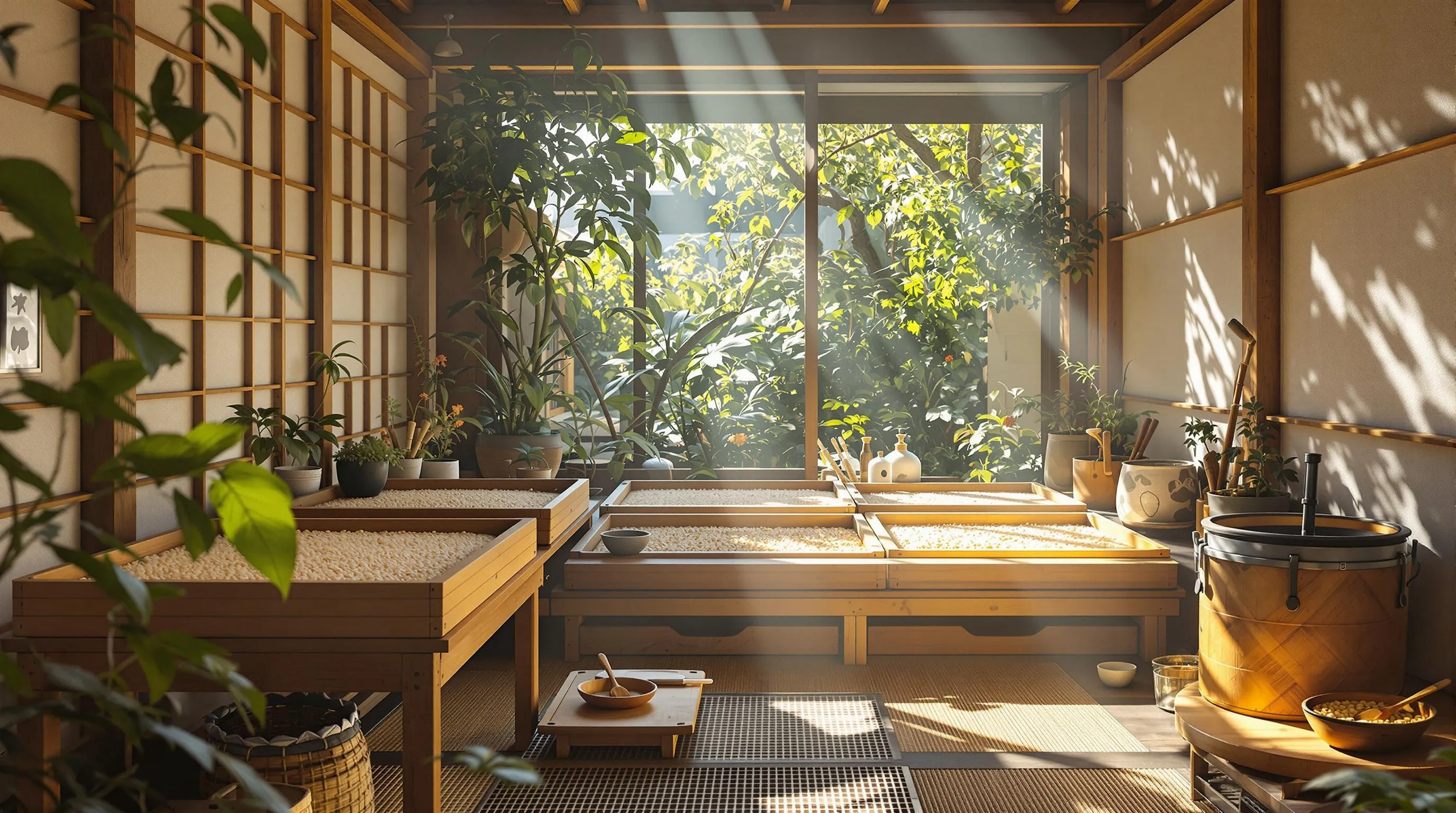
Koji, the foundation of many Japanese ferments including miso, sake, and shoyu, requires exact conditions to thrive in your backyard fermentation setup. This ancient culinary art transforms ordinary ingredients into complex, umami-rich foods through the cultivation of Aspergillus oryzae mold on grains like rice or barley. Setting up a dedicated koji room allows you to master these traditional techniques right in your backyard.
Temperature and Humidity Requirements for Koji Cultivation
Koji cultivation demands precise environmental control with temperatures between 85-95°F (29-35°C) and humidity levels of 60-70%. Your backyard koji room should feature reliable insulation to maintain these conditions consistently throughout the 48-hour fermentation period. Install a programmable thermostat connected to a heating element like a space heater or heating pad to regulate temperature. For humidity management, use ultrasonic humidifiers or wet towels placed near heat sources. Consider adding hygrometers in multiple locations to monitor conditions accurately, as even minor fluctuations can significantly impact koji development. Many koji enthusiasts use incubation chambers built from modified coolers or insulated boxes with heat mats to maintain these precise conditions in smaller spaces before scaling up to a full room.
Specialized Equipment for Asian Fermentation Methods
Equip your koji room with traditional tools that have stood the test of time. Cedar koji trays (known as “kojibuta”) provide the ideal surface for grain inoculation, allowing proper air circulation while maintaining humidity. Include a sturdy wooden table for working with the substrate and a specialized turning tool called a “kai” for gently mixing the developing koji without damaging the delicate mycelium. Store your koji spores (tane koji) in airtight containers in a refrigerator dedicated to fermentation cultures. Install shelving units made of natural materials like bamboo or cedar that won’t react with the high humidity environment. For serious enthusiasts, automatic koji machines (suitable for outdoor use with proper protection) can control temperature and humidity while periodically stirring the grain, though traditional hand methods often produce superior flavor complexity and connect you more deeply with this ancient practice.
Building a Community Fermentation Gathering Space in Your Backyard
Your backyard fermentation station isn’t just about creating delicious foods and beverages—it’s about embracing a sustainable lifestyle that connects you to ancient traditions while looking toward the future. Whether you choose a solar-powered cabinet a dedicated brewing shed or a simple repurposed cart you’re creating a space that reflects your unique approach to food production.
As you build your fermentation headquarters remember that flexibility is key. Start small and expand as your skills and interests grow. The beauty of outdoor fermentation lies in its adaptability to your space and climate.
Ready to transform your backyard into a fermentation paradise? The possibilities are endless and the rewards—flavorful creations deeper connections with your food and reduced environmental impact—are well worth the effort.





